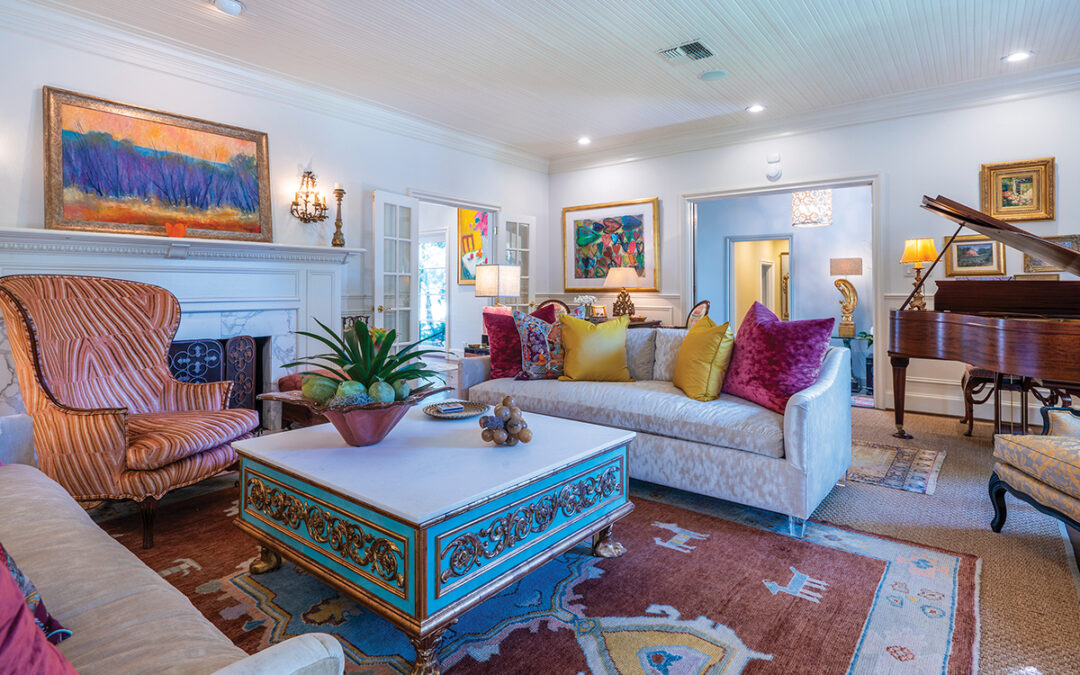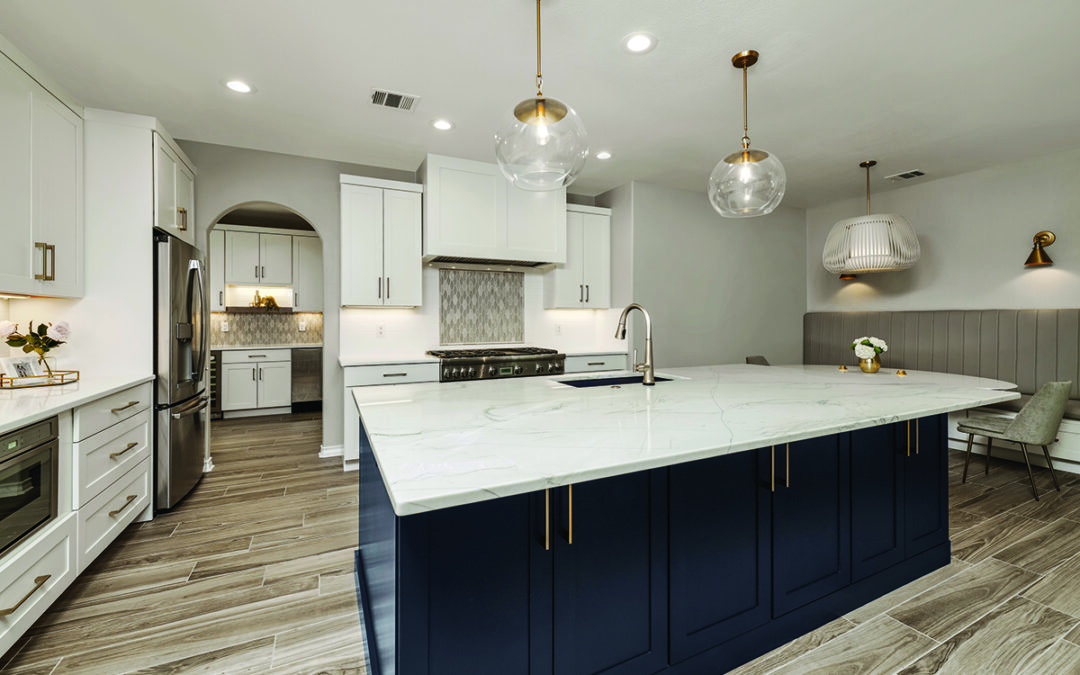The thoroughly contemporary home of Dr. Joseph Murgo and his wife, Toni, sprawls in linear fashion in the midst of a little bit of heaven on earth. More specifically, their home of 18- plus years is strategically situated on the peak of a Hill Country foothill with a breathtaking 360-degree view of the very best Mother Nature has to offer.
It’s an understatement to say the Murgo home is unique in design. The house is located on multilevels, with surprising twists and turns here and there. It includes a full greenhouse within the home, and one entire wing is a squash court, complete with observation gallery and dressing rooms.
Exquisite flowers bloom throughout the property and offer splendid color around the taupe stucco structure. Typical Hill Country wildlife abounds, and a mountain lion’s tracks were once observed.
The property was purchased in 1983, says Joe, a San Antonio cardiologist. Toni, an enthusiastic multitask administrator for Texas Public Radio in San Antonio, explains how their move from city to hilltop living evolved. While raising three sons in Whispering Oaks, “we saw many of our neighbors and friends moving to Elm Creek and then on to The Dominion, so we wanted something where we were not cheek-by-jowl in proximity to other houses.”
Joe relates that he happened on their current property, a former deer lease, “quite by accident.” The 38 densely wooded acres he previewed (prior to its going on the market) beckoned, in a manner of speaking, and a sale ensued. “I would four-wheel up the hill with a stepladder in the back of my pickup so I could climb up and see above the trees. I thought it (the property) had enormous possibility, but Toni thought I was crazy,” he laughs. Smiling and nodding acquiescence, Toni has long appreciated her husband’s ability to foresee the potential that eluded her at the outset.
Readying the hilltop for home and habitation was a formidable task that required the hiring of an engineer and considerable dynamite. Just under half the original acreage has been sold, and the Murgos’ home centers on three and a half acres of finely landscaped and manicured property within a very private and still densely wooded 17 acres.
“When we lived in Whispering Oaks, we moved into a house of brick and redwood to which we were very much attracted,” says Joe. It was a house designed by architect Jerry Theis, and admiration of his work led the Murgos to hire him for their hilltop project. The doctor mentions the architect spent an incredible amount of time on the property to ascertain how the home could take maximum advantage of two specific natural elements, summer and winter sunrise and sunset.
“The summer sunrise and sunset are on the side of the house where we purposely have little glass,” explains Joe. Summer heat is thereby kept to a minimum within the home. As for the winter sun, the house derives “maximum benefit from the winter sun on the side of the house where there are great expanses of glass,” says the physician.
The aforementioned linear structure is set on a 30-degree angle at each end of the house. That angle is mirrored in the design of the swimming pool, which centers and is viewed from the main living area.
Typically, a Texas foothill offers little more than limestone bedrock, so the Murgos had to reinvent the earth (import rich soil up the hill in massive quantities) to support the current landscape design. The plan includes scores of Texas mountain laurel trees that embrace the lawn in a semicircle and overwhelm the senses with fragrant delight each spring.
At the lower-level front entrance to the home, a breezeway whips a welcoming air current around arriving visitors. “It (the breezeway) is designed with the Venturi effect,” says Joe. “The breeze comes into the area through a large opening and exits through a smaller aperture, and it must pick up velocity to do so,” he explains. Thus you have an area generally 10 degrees cooler in July and August than you find elsewhere in the city and a constant delightful breeze.
The Venturi principle is experienced when currents of air whip between downtown buildings. The effect is evident, as well, in the capillaries of the human circulatory system, an apropos application for the dwelling of a cardiologist.
The home’s ambiance is minimalist and monochromatic, creating an atmosphere that is both relaxing and comfortable. Toni credits interior designer Robin Black with invaluable assistance. The elegant simplicity in design marries well with great expanses of glass, offering a nod to the importance of the home’s Hill Country surroundings.
Three bedrooms, a game room, quarters and a four-car garage make up one wing, while the squash court and gallery style greenhouse form the other wing. The central living room, with off white walls, is floored in white oak.
Furniture in the room was designed and made by Rudy de Leon of Rudy’s Custom Upholstery and Design Inc. in Olmos Park. Beneath the glass and chrome coffee table is a carpet from Kashmir with soft and subtle colors of blue, ivory and taupe. “Those are not the usual colors found in such carpets,” observes Toni.
Ecru leather and chrome Barcelona chairs offer architectural interest. Builtin glass shelves hold art glass. Signed and numbered Swedish Orrefors crystal pieces join a glass replica of two Orca whales. The latter, purchased in Maui, are a sentimental reminder of Joe’s volunteer work monitoring the fetal heartbeats of some favored mammal “friends” at Sea World. Unique and colorful Kashmirian papier-mâché boxes resemble Russian lacquered containers.
A grand piano anchors an area of the living space and speaks to Joe’s musical talent. Until two and a half years ago, he commuted weekly for 13 years between San Antonio and New Orleans, where most recently he was director of Tulane University Health Sciences Center’s Cardiovascular Center of Excellence. It was there he founded and directed a choral group that included all manner of Tulane employees, from world-renowned scientists to secretaries.
His other positions at the medical school included head of the cardiology section and professor of medicine. Previously, he was section head of cardiology and medical director of the world-famous Ochsner Heart and Vascular Institute.
Toni mentions that the two-city lifestyle was actually quite fun. At one point, Joe lived in a high-rise overlooking downtown New Orleans, and frequent getaways there for her were more than delightful.
The Murgos’ living area and nearby dining room are jointly served by a limestone fireplace. Black Angolan granite forms the base of a dining table surrounded by chrome and leather chairs. The carpet is Persian. Crystal cylinders hang from three star-shaped tiers in a whimsical, contemporary chandelier.
Art in the living and dining areas includes work by Thomas Pradzyndki of New Orleans, Nissan Engel serigraphs found at the Elliott Gallery in New Orleans and a café scene by David Schneuer.
Sleek kitchen cabinetry is by Poggenpohl, world-renowned leaders in European kitchen design. Counter tops are exquisite Brazilian granite. Both Toni and Joe enjoy cooking and entertaining, and accouterments within this area would thrill the most discriminating culinary aficionado.
Furnishings in the second-level master suite are by de Leon. Shades of ecru and off-white form the color palette in the room and echo the Italian marble bath within his and her dressing rooms. Artwork by Richard Conn and Martha Grant graces the walls. Seating is offered in small club chairs, while Joe’s Swedish recliner is a comfortable and therapeutic alternative. The fireplace is one of three in the home.
Joe’s office nearby holds a painting by colleague and retired cardiologist Hal Martin. Granite forms the desktops, and a look to the elegant grounds beyond draws the eye. Two contemporary drop lights are unusual in that throughout the home lighting is recessed — unobtrusive but highly effective.
Lest anyone think medicine and music are the only talents in this doctor’s bag, his wife points to any number of elements within the home that he designed, not the least of which is the fairly recent enclosing of a major expanse of upper deck at the center of the home’s second level.
The resulting very large room holds electrical outlets and recessed scene lighting at the ready for the installation of a miniature railroad. The trains are lined up on a cabinet, awaiting the flow of Joe’s creativity. A newly arrived grandson, who joins a granddaughter, might well be the motivator.
Author: Kay McKay Myers
Photographer: Al Rendon









0 Comments